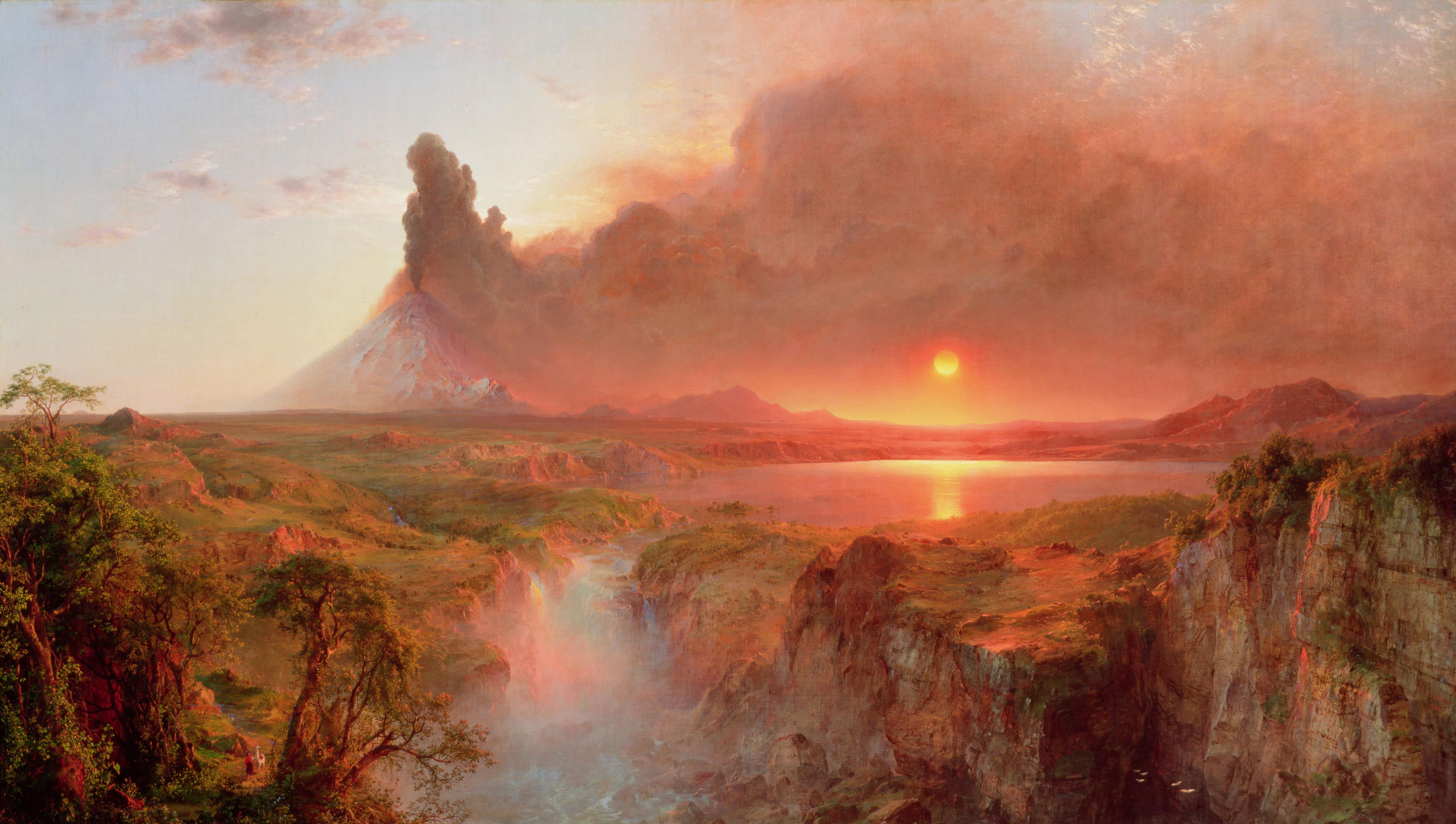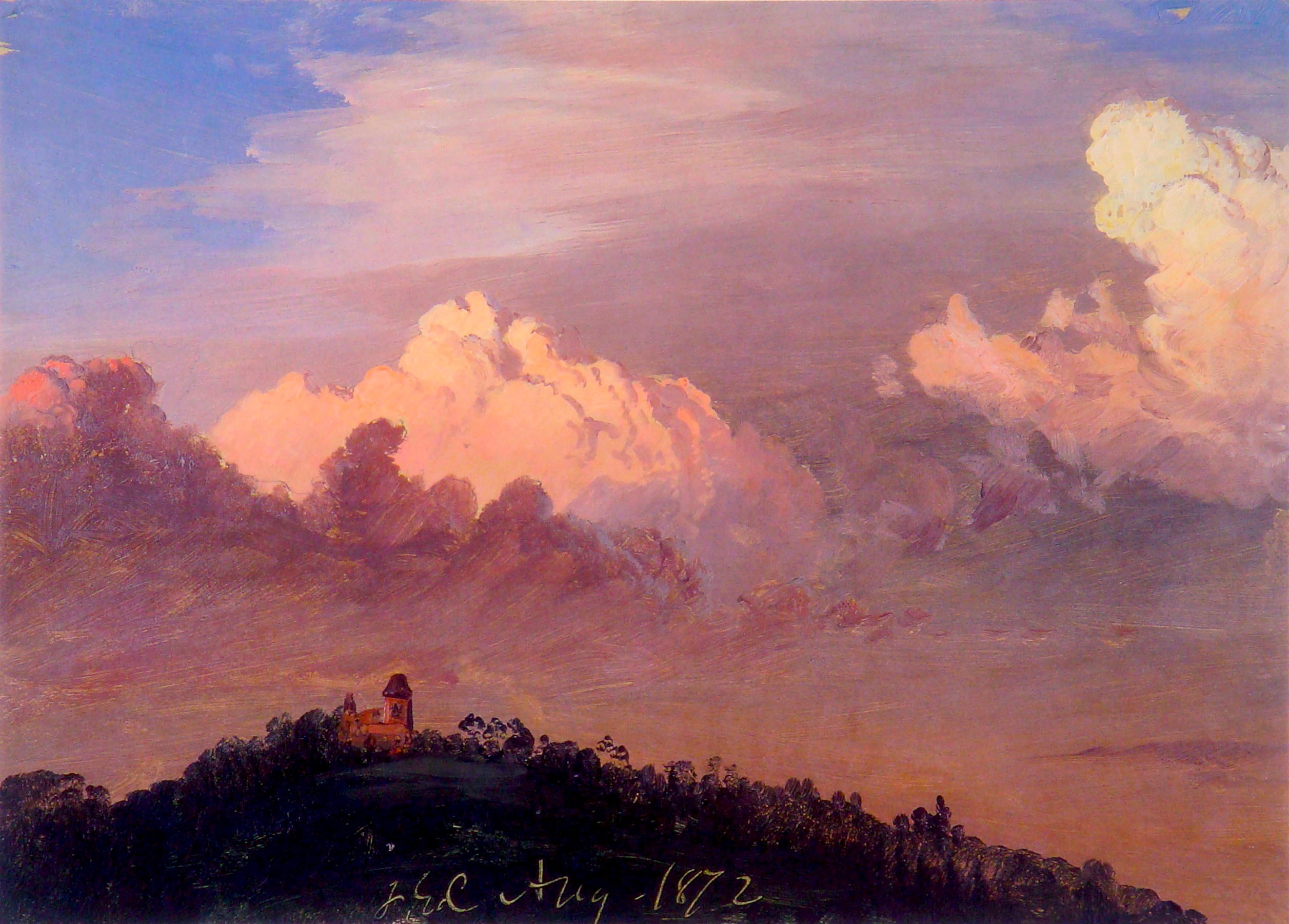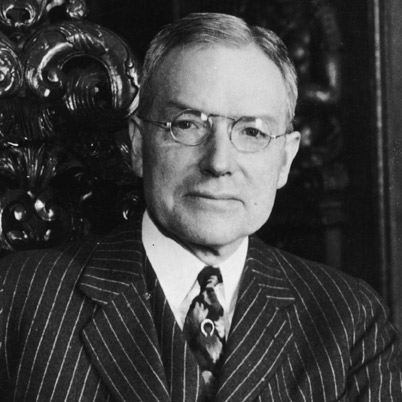|
El Khasné, Petra (painting)
''El Khasné, Petra'' is an 1874 oil painting by American landscape artist Frederic Edwin Church. It is a depiction of the Al-Khazneh temple in the historical city of Petra, Jordan, which Church visited during an extended trip to the Middle East and Europe in 1867 and 1868. He visited the tomb with American missionary D. Stuart Dodge in February 1868 and made sketches there. The painting is located at Olana State Historic Site Olana State Historic Site is a historic house museum and landscape in Greenport, New York, near the city of Hudson. The estate was home to Frederic Edwin Church (1826–1900), one of the major figures in the Hudson River School of landscape pain ..., the preserved homestead where Church lived in his later years. It may be the last canvas that he painted entirely with his right hand, owing to worsening rheumatoid arthritis. The mausoleum is carved out of sandstone and at the time was only approachable by the depicted passageway, called the Siq. Church co ... [...More Info...] [...Related Items...] OR: [Wikipedia] [Google] [Baidu] |
Oil Painting
Oil painting is the process of painting with pigments with a medium of drying oil as the binder. It has been the most common technique for artistic painting on wood panel or canvas for several centuries, spreading from Europe to the rest of the world. The advantages of oil for painting images include "greater flexibility, richer and denser colour, the use of layers, and a wider range from light to dark". But the process is slower, especially when one layer of paint needs to be allowed to dry before another is applied. The oldest known oil paintings were created by Buddhist artists in Afghanistan and date back to the 7th century AD. The technique of binding pigments in oil was later brought to Europe in the 15th century, about 900 years later. The adoption of oil paint by Europeans began with Early Netherlandish painting in Northern Europe, and by the height of the Renaissance, oil painting techniques had almost completely replaced the use of tempera paints in the majority ... [...More Info...] [...Related Items...] OR: [Wikipedia] [Google] [Baidu] |
Frederic Edwin Church
Frederic Edwin Church (May 4, 1826 – April 7, 1900) was an American landscape painter born in Hartford, Connecticut. He was a central figure in the Hudson River School of American landscape painters, best known for painting large landscapes, often depicting mountains, waterfalls, and sunsets. Church's paintings put an emphasis on realistic detail, dramatic light, and panoramic views. He debuted some of his major works in single-painting exhibitions to a paying and often enthralled audience in New York City. In his prime, he was one of the most famous painters in the United States. Biography Beginnings Frederic Edwin Church was a direct descendant of Richard Church, a Puritan pioneer from England who accompanied Thomas Hooker on the original journey through the wilderness from Massachusetts to what would become Hartford, Connecticut. Church was the son of Eliza (1796–1883) and Joseph Church (1793–1876). Frederic had two sisters and no surviving brothers. His father w ... [...More Info...] [...Related Items...] OR: [Wikipedia] [Google] [Baidu] |
Olana State Historic Site
Olana State Historic Site is a historic house museum and landscape in Greenport, New York, near the city of Hudson. The estate was home to Frederic Edwin Church (1826–1900), one of the major figures in the Hudson River School of landscape painting. The centerpiece of Olana is an eclectic villa which overlooks parkland and a working farm designed by the artist. The residence has a wide view of the Hudson River Valley, the Catskill Mountains and the Taconic Range. Church and his wife Isabel (1836–1899) named their estate after a fortress-treasure house in ancient Greater Persia (modern-day Armenia), which also overlooked a river valley. Olana is one of the few intact artists' home-, studio- and estate-complexes in the United States; it was designated a National Historic Landmark in 1965. and The house is also a prime example of Orientalist architecture. It is owned and operated by the New York State Office of Parks, Recreation and Historic Preservation, and is also ... [...More Info...] [...Related Items...] OR: [Wikipedia] [Google] [Baidu] |
Al-Khazneh
Al-Khazneh ( ar, الخزنة; "The Treasury") is one of the most elaborate temples in Petra, a city of the Nabatean Kingdom inhabited by the Arabs in ancient times. As with most of the other buildings in this ancient town, including the Monastery (Arabic: Ad Deir), this structure was carved out of a sandstone rock face. The structure is believed to have been the mausoleum of the Nabatean King Aretas IV in the 1st century AD. It is one of the most popular tourist attractions in both Jordan and the region. It became known as "Al-Khazneh", or The Treasury, in the early 19th century by the area's Bedouins as they had believed it contained treasures. Name Al-Khazneh means "The Treasury" in Arabic, a name derived from legends regarding the decorative stone urn high on the second level, which in reality is solid sandstone. One legend is that the Egyptian Pharaoh and some of his armies escaped the closing of the Red Sea, created the Khazneh by magic as a safe place for his trea ... [...More Info...] [...Related Items...] OR: [Wikipedia] [Google] [Baidu] |
Petra
Petra ( ar, ٱلْبَتْرَاء, Al-Batrāʾ; grc, Πέτρα, "Rock", Nabataean: ), originally known to its inhabitants as Raqmu or Raqēmō, is an historic and archaeological city in southern Jordan. It is adjacent to the mountain of Jabal Al-Madbah, in a basin surrounded by mountains forming the eastern flank of the Arabah valley running from the Dead Sea to the Gulf of Aqaba. The area around Petra has been inhabited from as early as 7000 BC, and the Nabataeans might have settled in what would become the capital city of their kingdom as early as the 4th century BC. Archaeological work has only discovered evidence of Nabataean presence dating back to the second century BC, by which time Petra had become their capital. The Nabataeans were nomadic Arabs who invested in Petra's proximity to the incense trade routes by establishing it as a major regional trading hub. The trading business gained the Nabataeans considerable revenue and Petra became the focus of their ... [...More Info...] [...Related Items...] OR: [Wikipedia] [Google] [Baidu] |
Jordan
Jordan ( ar, الأردن; tr. ' ), officially the Hashemite Kingdom of Jordan,; tr. ' is a country in Western Asia. It is situated at the crossroads of Asia, Africa, and Europe, within the Levant region, on the East Bank of the Jordan River. Jordan is bordered by Saudi Arabia to the south and east, Iraq to the northeast, Syria to the north, and the Palestinian West Bank, Israel, and the Dead Sea to the west. It has a coastline in its southwest on the Gulf of Aqaba's Red Sea, which separates Jordan from Egypt. Amman is Jordan's capital and largest city, as well as its economic, political, and cultural centre. Modern-day Jordan has been inhabited by humans since the Paleolithic period. Three stable kingdoms emerged there at the end of the Bronze Age: Ammon, Moab and Edom. In the third century BC, the Arab Nabataeans established their Kingdom with Petra as the capital. Later rulers of the Transjordan region include the Assyrian, Babylonian, Roman, Byzantin ... [...More Info...] [...Related Items...] OR: [Wikipedia] [Google] [Baidu] |
Reverend David Stuart Dodge
Rev. David Stuart Dodge (1836–1921) was a friend and supporter of the Reverend Dr. Daniel Bliss, the founder of the Syrian Protestant College, Beirut. Dodge became the professor for English and modern languages at the institute, a position he held for nine years. He was later appointed the America-based chairman of trustees for the college. Syrian Protestant College Dodge was the third son of wealthy New York merchant William Earl Dodge and Melissa Phelps. He was educated at the Phillips Academy at Andover before attending Yale and later the Union Theological Seminary from where he graduated in 1860. In the same year he married, Ellen Ada Phelps, the daughter of John Jay Phelps and Rachel Badgeley Phinney.The Dodge and Phelps families were next door neighbours in Madison Avenue. Their honeymoon took them to the Holy Land where they met and befriended the Reverend Daniel Bliss and his wife Abby Wood who had been in Syria for five years, working for the American Board of Co ... [...More Info...] [...Related Items...] OR: [Wikipedia] [Google] [Baidu] |
Bedouin
The Bedouin, Beduin, or Bedu (; , singular ) are nomadic Arabs, Arab tribes who have historically inhabited the desert regions in the Arabian Peninsula, North Africa, the Levant, and Mesopotamia. The Bedouin originated in the Syrian Desert and Arabian Desert but spread across the rest of the Arab world in Western Asia, West Asia and North Africa after the spread of Islam. The English word ''bedouin'' comes from the Arabic ''badawī'', which means "desert dweller", and is traditionally contrasted with ''ḥāḍir'', the term for Sedentism, sedentary people. Bedouin territory stretches from the vast deserts of North Africa to the rocky sands of the Middle East. They are traditionally divided into tribes, or clans (known in Arabic as ''ʿašāʾir''; or ''qabāʾil'' ), and historically share a common culture of herding camels and goats. The vast majority of Bedouins adhere to Islam, although there are some fewer numbers of Arab Christians, Christian Bedouins present in the Fe ... [...More Info...] [...Related Items...] OR: [Wikipedia] [Google] [Baidu] |
Paintings By Frederic Edwin Church
Painting is the practice of applying paint, pigment, color or other medium to a solid surface (called the "matrix" or "support"). The medium is commonly applied to the base with a brush, but other implements, such as knives, sponges, and airbrushes, can be used. In art, the term ''painting ''describes both the act and the result of the action (the final work is called "a painting"). The support for paintings includes such surfaces as walls, paper, canvas, wood, glass, lacquer, pottery, leaf, copper and concrete, and the painting may incorporate multiple other materials, including sand, clay, paper, plaster, gold leaf, and even whole objects. Painting is an important form in the visual arts, bringing in elements such as drawing, Composition (visual arts), composition, gesture (as in gestural painting), narrative, narration (as in narrative art), and abstraction (as in abstract art). Paintings can be naturalistic and representational (as in still life and landscape art, lands ... [...More Info...] [...Related Items...] OR: [Wikipedia] [Google] [Baidu] |
1874 Paintings
Events January–March * January 1 – New York City annexes The Bronx. * January 2 – Ignacio María González becomes head of state of the Dominican Republic for the first time. * January 3 – Third Carlist War – Battle of Caspe: Campaigning on the Ebro in Aragon for the Spanish Republican Government, Colonel Eulogio Despujol surprises a Carlist force under Manuel Marco de Bello at Caspe, northeast of Alcañiz. In a brilliant action the Carlists are routed, losing 200 prisoners and 80 horses, while Despujol is promoted to Brigadier and becomes Conde de Caspe. * January 20 – The Pangkor Treaty (also known as the Pangkor Engagement), by which the British extended their control over first the Sultanate of Perak, and later the other independent Malay States, is signed. * January 23 **Prince Alfred, Duke of Edinburgh, second son of Queen Victoria, marries Grand Duchess Maria Alexandrovna of Russia, only daughter of Tsar Alexander III of Russ ... [...More Info...] [...Related Items...] OR: [Wikipedia] [Google] [Baidu] |
Paintings In New York (state)
Painting is the practice of applying paint, pigment, color or other medium to a solid surface (called the "matrix" or "support"). The medium is commonly applied to the base with a brush, but other implements, such as knives, sponges, and airbrushes, can be used. In art, the term ''painting ''describes both the act and the result of the action (the final work is called "a painting"). The support for paintings includes such surfaces as walls, paper, canvas, wood, glass, lacquer, pottery, leaf, copper and concrete, and the painting may incorporate multiple other materials, including sand, clay, paper, plaster, gold leaf, and even whole objects. Painting is an important form in the visual arts, bringing in elements such as drawing, composition, gesture (as in gestural painting), narration (as in narrative art), and abstraction (as in abstract art). Paintings can be naturalistic and representational (as in still life and landscape painting), photographic, abstract, narrative, s ... [...More Info...] [...Related Items...] OR: [Wikipedia] [Google] [Baidu] |
Architecture Paintings
Architecture is the art and technique of designing and building, as distinguished from the skills associated with construction. It is both the process and the product of sketching, conceiving, planning, designing, and constructing buildings or other structures. The term comes ; ; . Architectural works, in the material form of buildings, are often perceived as cultural symbols and as works of art. Historical civilizations are often identified with their surviving architectural achievements. The practice, which began in the prehistoric era, has been used as a way of expressing culture for civilizations on all seven continents. For this reason, architecture is considered to be a form of art. Texts on architecture have been written since ancient times. The earliest surviving text on architectural theories is the 1st century AD treatise ''De architectura'' by the Roman architect Vitruvius, according to whom a good building embodies , and (durability, utility, and beauty). Ce ... [...More Info...] [...Related Items...] OR: [Wikipedia] [Google] [Baidu] |







